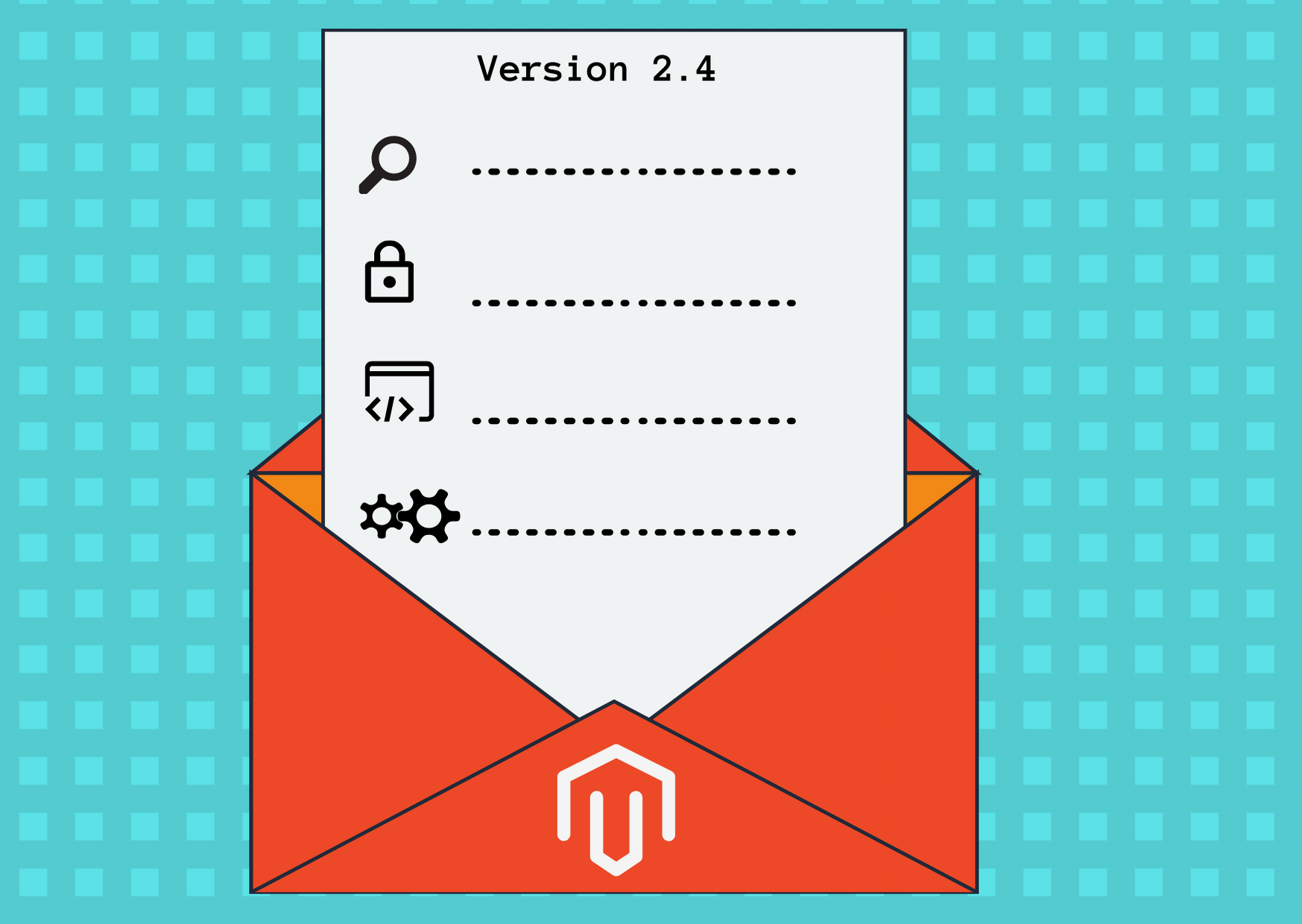Magento 2.4 overview. What’s new in it?

Introduction
Magento is a great eCommerce platform favored by many – and its updates and releases always come into the spotlight. We have already discussed the importance of the Migration from M1 to M2 and how it will benefit your eCommerce business. Now it’s time to look at one of the latest updates - 2.4 and explore its new features.
Key Highlights
Magento 2.4.0 release date incurred on 28th of July 2020. Apart from support for PHP 7.4, it includes 98 new features, 68 bug fixes, 50 security changes, 7 test cycles, 12 packages & extensions. The latest update 2.4.2 took place in February 2021 and is readily available for download. As a standard practice, Magento provides both Open Source and Commerce versions so that you can choose the best solution for your business.
Progressive Web Application Studio
Progressive Web Application (PWA) is a highly modern approach that enables installing web apps on mobile devices. It imitates native mobile applications and even allows accessing content offline without an active internet connection. Mobile sales account for over 53% of total sales and are estimated to increase annually. Magento integrated PWAStudio in the release 2.3 a few years ago, becoming one of the first eCommerce platforms that provide PWA building.
According to Magento’s PWA studio Roadmap, there have been several enhancements in the current release and many more to come in the future ones. Magento 2.4 supports PWA Studio version 8.0.0, which has a lot of improvement for storefront performance. The time of API requests is shortened, which makes page responsiveness quicker and smoother. Another prominent feature is the completion of checkout and cart work-flow with respect to the newest UX research. The purpose is to simplify both the implementation and usage of checkout and cart components customization.
This PWA release also presents an entirely new Shopping Bag feature called floating modal, displayed when the shopping bag symbol is tapped. Besides, there are several improvements to account code preview and many branding updates.
As a consequence, PWA Studio provides more options, is easier to customize and implement.
New Media Gallery
Magento media assets have gone through some transformation, too. Administrators can now search, filter, and sort images up to 30 times faster. This tool allows analyzing the storefront image usage too.
Security
Magento takes security updates as one of its highest priorities. In 2.4, Magento has provided a security-only patch that enables installing time-sensitive security fixes. This is a significant improvement as, alternatively, merchants would be required to apply hundreds of functional fixes and enhancements manually. This patch collects a quarterly amount of fixes for vulnerabilities in one install and saves time and development effort. It is important to remember that security-only patches fix security bugs only and do not provide new security enhancements and features. To get a full update, a whole patch installation is required.
Over 30 substantial security enhancements in this release aim to close remote code execution(RCE) and cross-site scripting (XSS) vulnerabilities. RCE is a type of vulnerability where an attacker can run the code they want with system-level privileges. Consequently, they might be gaining access to any type of information on a server, such as databases and payment details. XSS is a type of attack where malicious scripts are injected into trusted websites. This can directly harm users as their browsers get filled with malicious scripts from sources that did not indicate being compromised.
Therefore Magento 2.4 has made a big step forwards in addressing these major security issues. Since the release, there have been no confirmed attacks of this type. Magento also provides measures to protect the Admin rights to reduce the occurrence of other types of attacks. To support this, Magento has now released a mandatory Two Factor Authentication (2FA) for Admin. Besides, it is possible to extend 2FA to other Magento accounts and add a layer of security.
Platform upgrades
Several benefits come with Magento 2.4 in terms of the platform upgrades. Their purpose is to improve website security and performance. One of the major implementations is PHP 7.4 support, which will bring in all the benefits of the update. It is now possible to utilize the latest PHPUnit testing framework. For that extension, vendors must confirm that their new extensions are compatible and update them through Magento Marketplace.Both Commerce and Open Source Magento set the default catalog search engine to Elasticsearch 7.6.x. It needs to be installed and configured before upgrading to Magento 2.4. As for Elasticsearch, it provides superior search capabilities and is a major upgrade from the previous default catalog.Support for MySQL 8.0 has been enabled in Magento 2.4, so all of its advantages can be used by merchants. One of them is using MariaDB 10.4, which is now supported.Laminas project, a replacement for Zend Framework, will run the same way. However, further development will be done on the Laminas project under Linux Foundation management. The existing Zend Framework packages and third-party libraries have been moved onto new GitHub repositories to assist migration from the current Zend Framework to the Laminas project.
Infrastructure updates
Infrastructure updates bring enhancements to core quality, which can significantly improve the Magento Framework quality and several modules.One of the updates is a PayPal JavaScript SDK upgrade. Now, this SDK automatically collects and passes needed risk parametric to PayPal. This comes with severalsecurity updates and enhancements and partially automates the payment validation process.Seller-assisted shopping is another feature vital to merchants. It enables them to view the storefront on behalf of their customers. This process requires customers to permit to access their accounts. After the session is over and the administrator logs out, the sessions are destroyed. Customers do not need to provide their passwords either.Since Elasticsearch is now a default search engine, it has also gone through some transformation. It now allows customers to do a partial-word search of product names.
Performance updates
According to Magento, the general speed of Quick Order add-to-cart performance has been improved by 25-30%.Amongst many others, there also have been multiple improvements and optimizations on Redis (a data structure store). These improvements are to reduce the number of queries on each request, which, in return, will speed up data handling processes and reduce CPU usage. It also makes the communication network between Magento and Redis easier, which simplifies development.
Deprecations
There also are several major deprecations and removals. Without going into much detail, it is important to understand which tools are no longer available for better migration timing estimates.Removal of MySQL catalog search engine is one of the major ones, as it has now been replaced with Elasticsearch. It is not possible to keep on using the MySQL search catalog at Magento 2.4. Consequently, it will require optimization for businesses that are still using the MySQL catalog search engine.MySQL 5.6 has also been deprecated so ensure you migrate your database to a newer MySQL version.Zend Framework has now been deprecated and replaced by the Laminas project.Signifyd fraud protection code has been removed and replaced with Signifyd Fraud & Chargeback Protection extension available at Magento Marketplace.The core Braintree module has been removed from the codebase and has been replaced with the Braintree Payments module. Another payment module that was removed is the Authorize.Net payment method.Finally, the way to Install Magento has changed – Web Set Up Wizard has been deprecated.
What is next?
We have now gone through many features and enhancements – and you would be pleased to know that there are more to explore. Magento 2.4 is a major release, and an upgrade will always make your eCommerce shop stand out.
How long will the upgrade to Magento 2.4 take? There is a number of factors to consider. First of all, it depends on the current version of your store. The difference between versions can vary from months to a couple of years of development (for example, if you still have not completed the migration from Magento 1). Secondly, a lot depends on which features you would like to implement. Some will be a priority, such as a default search engine replacement, while some, such as Media Gallery, can be optional. Another point is the scope and nature of the business. Finally, the number of resources available will also affect timing.
The roadmap of an upgrade is a complex and responsible process and is best handled by professionals. At WiserBrand are always happy to create the best migration experience for you, from planning to implementation.
